To create a detailed HVAC project schedule, there are several methods and considerations that can be used. Whether you are an HVAC project manager or a professional in the construction industry, this guide will provide you with valuable insights on HVAC project scheduling.
In this section, we will discuss the process of creating detailed HVAC project schedules. We will explore various methods, tools, and best practices to improve your project timeline and enhance efficiency.
One important aspect of HVAC project scheduling is utilizing HVAC scheduling software, which can streamline the scheduling process and provide you with accurate and up-to-date information.
Key Takeaways:
- The Critical Path Method (CPM) helps identify dependent tasks and allows for adjustments to the completion date.
- The Program Evaluation and Review Technique (PERT) estimates completion dates based on different schedule forecasts.
- Gantt charts can be used to track progress and identify problems and delays in HVAC projects.
- The Line of Balance (LOB) method is useful for projects with repeated tasks, optimizing resource allocation and project coordination.
- Quantitative scheduling focuses on resource allocation while considering time and other constraints.
Understanding the Critical Path Method (CPM)
When it comes to creating a detailed HVAC project schedule, one method that stands out is the Critical Path Method (CPM). This widely-used approach helps identify dependent tasks and allows for adjustments to the completion date. By analyzing the sequence of activities and their dependencies, you can determine the critical path – the longest sequence of tasks that determines the overall project duration.
The CPM technique involves breaking down the project into smaller activities, estimating their durations, and establishing logical relationships between them. By doing so, you can identify which tasks are critical and must be completed in a specific order, as any delay in these activities will impact the project’s overall timeline. With a clear understanding of the critical path, you can allocate resources and manage the project efficiently, ensuring that deadlines are met.
It is important to note that the Critical Path Method is not a standalone tool but rather a technique that can be supported by scheduling software. By utilizing HVAC project scheduling software, you can automate the calculation of critical paths, identify slack time, and visualize the project timeline. This software allows for better coordination and communication among team members, ultimately leading to more successful HVAC projects.
Benefits of the Critical Path Method:
- Identifies the critical path and determines project duration
- Helps allocate resources effectively
- Enables better coordination and communication among team members
- Allows for adjustments to the completion date by modifying the critical path
By understanding and implementing the Critical Path Method effectively, HVAC project managers can ensure smoother project execution and timely completion, leading to greater customer satisfaction and success in the construction industry.
| CPM Steps | Description |
|---|---|
| 1 | Identify all project activities and their dependencies |
| 2 | Determine the duration of each activity |
| 3 | Create a network diagram to visualize the project schedule |
| 4 | Calculate the earliest start time and earliest finish time for each activity |
| 5 | Calculate the latest start time and latest finish time for each activity |
| 6 | Identify the critical path and determine project duration |
| 7 | Allocate resources and manage the project timeline |
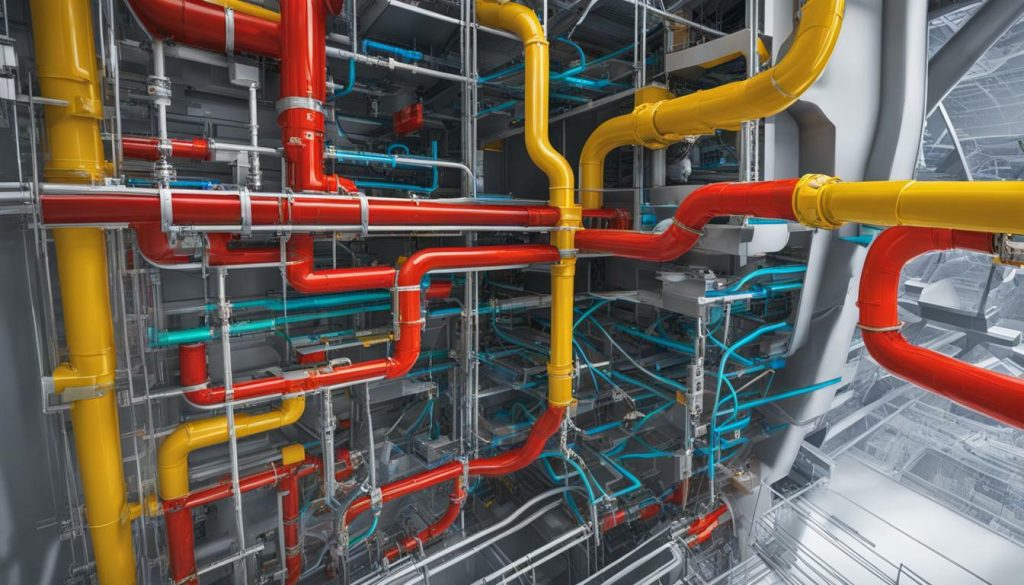
Section 3: Utilizing the Program Evaluation and Review Technique (PERT)
The Program Evaluation and Review Technique (PERT) is a valuable method for creating accurate project schedules in the HVAC industry. PERT estimates completion dates based on optimistic, pessimistic, and most likely schedule forecasts, allowing for effective management of uncertainties. By using PERT, you can develop detailed schedules that enhance project planning and execution.
When implementing PERT, it is important to identify the critical activities and their dependencies in your HVAC project. This will help you determine the optimal sequence of tasks and allocate resources accordingly. By analyzing the potential risks and durations associated with each activity, you can create realistic schedules that take into account various project uncertainties.
PERT offers a visual representation of the project schedule, highlighting the critical path and non-critical tasks. The critical path consists of activities that must be completed on time in order to meet the project deadline. By focusing on the critical path, you can identify potential bottlenecks and allocate resources effectively to ensure timely completion.
| Benefits of PERT for HVAC Project Scheduling |
|---|
| Accurate estimation of project completion dates |
| Effective management of uncertainties and risks |
| Identification of critical tasks and resource allocation |
| Enhanced project planning and execution |
By utilizing the Program Evaluation and Review Technique (PERT), HVAC project managers can create detailed schedules that optimize resource allocation, manage uncertainties, and ensure timely project completion. Incorporate PERT into your scheduling process to enhance project planning and execution, ultimately leading to successful HVAC projects.

Section 4: Tracking Progress with Gantt Charts
Gantt charts are an essential tool for tracking progress and identifying problems and delays in HVAC projects. By visualizing your project timeline and allocating resources effectively, Gantt charts enable smooth coordination among team members. Here’s how you can use Gantt charts effectively in your HVAC project scheduling:
- Create a Gantt chart that includes all the tasks and activities involved in your HVAC project. Break down the project into smaller tasks and allocate appropriate durations for each task.
- Assign team members to specific tasks and indicate their responsibilities and deadlines on the Gantt chart. This helps in resource allocation and ensures accountability.
- Track the progress of each task by updating the Gantt chart regularly. This allows you to identify any delays or bottlenecks and take necessary corrective action.
- Use milestones in the Gantt chart to mark significant project achievements or deadlines. This provides a clear overview of the project’s progress and helps in monitoring its overall timeline.
By incorporating Gantt charts into your HVAC project scheduling, you can effectively track progress, allocate resources efficiently, and ensure timely completion of your projects.
![]()
| Task | Start Date | End Date | Assigned To |
|---|---|---|---|
| Site Assessment | 01/05/2022 | 07/05/2022 | John |
| Design HVAC System | 10/05/2022 | 30/05/2022 | Emily |
| Procure Equipment | 01/06/2022 | 15/06/2022 | David |
| Install HVAC System | 20/06/2022 | 30/07/2022 | Team |
The table above shows a simple example of a Gantt chart for an HVAC project. It includes tasks, start and end dates, and the team members assigned to each task. By regularly updating this chart and tracking progress, you can ensure that your HVAC project stays on schedule and meets its deadlines.
Line of Balance (LOB) Method for HVAC Projects
The Line of Balance (LOB) method is a valuable technique for scheduling HVAC projects that involve repeated tasks. This method helps optimize resource allocation and enhance project coordination, ensuring efficient execution and timely completion.
By utilizing the LOB method, you can create a schedule that maximizes productivity and minimizes downtime. The key principle of LOB is to divide the project into separate production lines, each representing a specific task or activity. This allows for better visualization and management of the workflow, enabling you to identify potential bottlenecks and allocate resources more effectively.
One of the main benefits of the LOB method is its ability to streamline coordination among different teams or subcontractors involved in the HVAC project. By aligning the production lines and synchronizing the activities, you can minimize conflicts and ensure smooth collaboration. This leads to better communication, improved efficiency, and reduced project delays.
| Advantages of the LOB Method for HVAC Project Scheduling | Disadvantages of the LOB Method for HVAC Project Scheduling |
|---|---|
|
|
By implementing the LOB method, you can take control of your HVAC project’s timeline and ensure that each task is carried out efficiently. This method allows for better coordination, improved resource utilization, and minimized delays. Consider incorporating the LOB method into your HVAC project scheduling to achieve optimal results.
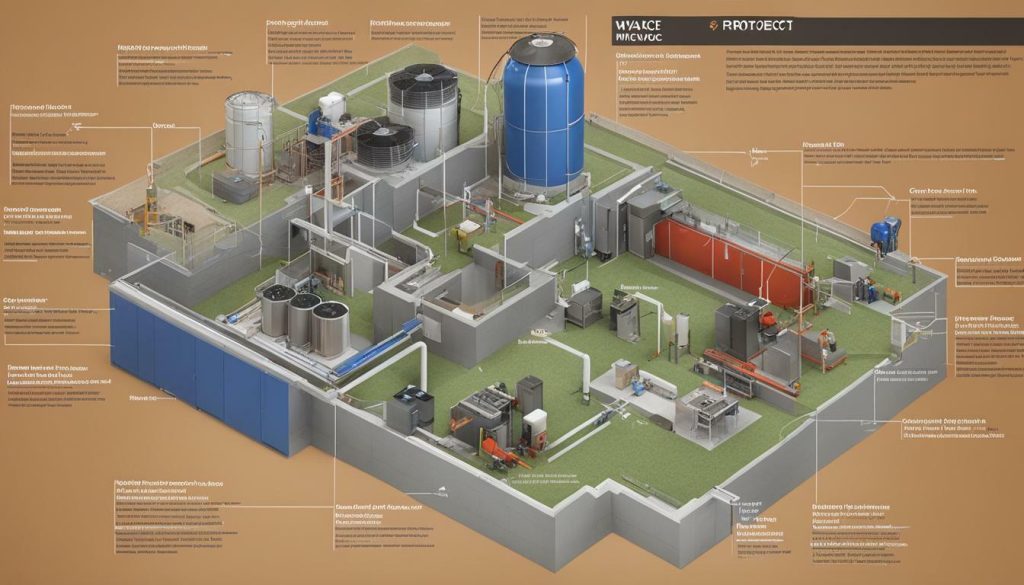
Implementing Quantitative Scheduling for HVAC Projects
When it comes to creating an effective schedule for HVAC projects, quantitative scheduling is a valuable technique to consider. This method focuses on resource allocation while taking into account time and other constraints. By implementing quantitative scheduling, you can ensure optimal resource utilization and project success.
To utilize quantitative scheduling effectively, start by identifying the resources required for each task in your HVAC project. This includes materials, equipment, and labor. Next, assess the availability of these resources and determine the duration needed for each task.
Once you have gathered this information, you can use quantitative scheduling tools or software to allocate resources based on their availability and prioritize tasks accordingly. This will help you create a detailed schedule that maximizes efficiency and minimizes resource wastage. By considering time and other constraints, you can ensure that your HVAC project stays on track and is completed within the desired timeframe.
| Benefits of Quantitative Scheduling in HVAC Projects |
|---|
| Optimal resource utilization |
| Efficient project execution |
| Realistic timelines |
| Effective coordination among team members |
By implementing quantitative scheduling in your HVAC projects, you can experience these benefits and ensure a smooth and successful project management process.
Example: Sample Quantitative Schedule for an HVAC Project
| Task | Duration (days) | Resources Required |
|---|---|---|
| Site Preparation | 3 | Labor, equipment |
| HVAC System Design | 7 | Engineer, software |
| Procurement of Materials | 5 | Procurement team |
| Installation of HVAC System | 14 | Labor, equipment |
| Testing and Commissioning | 7 | Engineer, testing equipment |
This is just a simplified example of how a quantitative schedule for an HVAC project might look. The actual schedule will depend on the specific requirements of your project. By using quantitative scheduling techniques, you can create a detailed schedule for your HVAC project that takes into account all necessary resources, durations, and constraints.
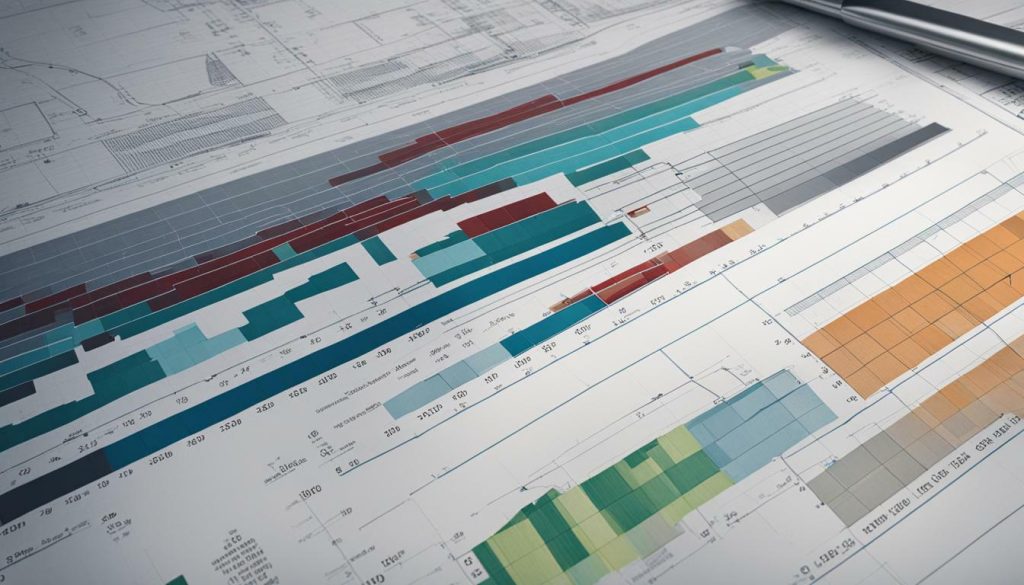
The Last Planner System in HVAC Project Scheduling
The Last Planner System is a highly effective approach to HVAC project scheduling that promotes collaboration and ensures efficient project execution. By dividing projects into planning stages, this system facilitates clear communication and coordination among team members, leading to better outcomes. Here’s how the Last Planner System can be implemented in HVAC project planning and execution.
Benefits of the Last Planner System
The Last Planner System offers several benefits for HVAC project scheduling. Firstly, it promotes a collaborative environment where all team members actively participate in the planning process. This leads to better coordination and understanding of project goals and requirements. Secondly, the Last Planner System helps identify potential bottlenecks and delays early on, allowing for proactive problem-solving and mitigating risks. By involving all stakeholders in the planning stages, the system facilitates buy-in and commitment to the project timeline. Lastly, the Last Planner System enhances transparency and accountability, as it provides a clear overview of project progress and empowers team members to take ownership of their tasks.
Implementing the Last Planner System
To implement the Last Planner System in HVAC project scheduling, follow these steps:
- Divide the project into planning stages: Break the project down into manageable phases, considering dependencies and logical sequences of tasks.
- Collaborative planning sessions: Conduct collaborative planning sessions involving all relevant team members. During these sessions, discuss task sequencing, resource allocation, and identify any constraints or potential risks.
- Create phase-level schedules: Develop detailed schedules for each planning stage, including the sequence of tasks, duration estimates, and resource requirements.
- Weekly work plans: Prepare weekly work plans that outline the specific tasks to be executed during each week. These plans should be developed collaboratively and should align with the overall project schedule.
- Monitor and adjust: Regularly monitor the progress of tasks and compare it against the planned schedule. Update the schedule as necessary, taking into account any changes or adjustments required.
By following these steps and leveraging the Last Planner System, HVAC project teams can streamline their scheduling processes and achieve more efficient project execution.
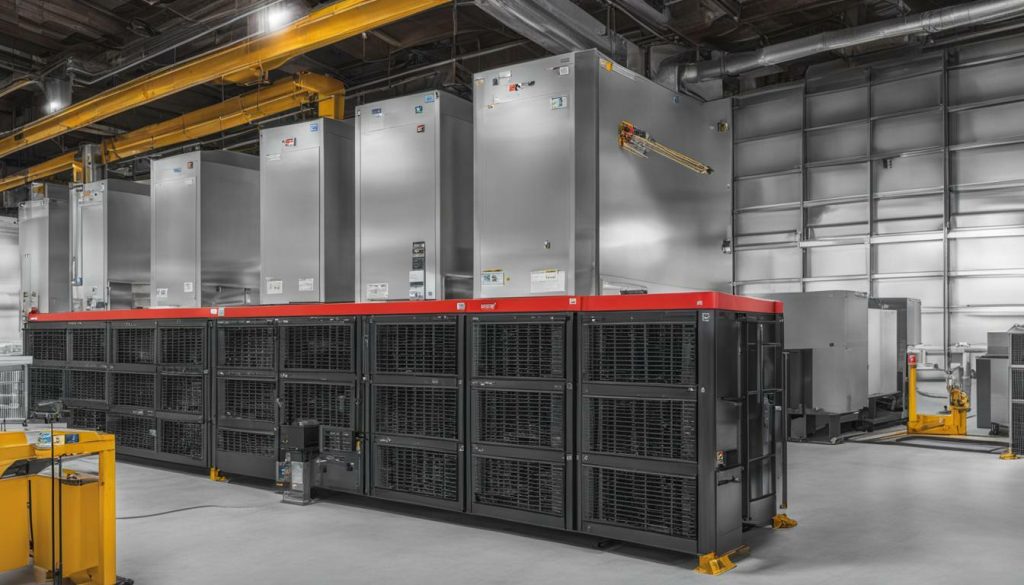
| Advantages of the Last Planner System | Challenges of the Last Planner System |
|---|---|
| Improved collaboration among team members | Resistance to change from team members |
| Early identification of potential delays | Lack of flexibility in case of unforeseen circumstances |
| Enhanced accountability and ownership | Dependency on reliable and accurate information |
| Better project coordination and communication | Time investment required for planning sessions |
Lookahead Planning for Short-Term Scheduling in HVAC Projects
In HVAC projects, lookahead planning plays a crucial role in creating a detailed schedule for the upcoming phases. By focusing on short-term scheduling, lookahead planning ensures that project progress is efficient and on track. This method allows project managers to anticipate potential challenges, allocate resources effectively, and address any delays promptly.
Lookahead planning involves breaking down the project timeline into smaller, manageable periods, typically ranging from one to four weeks. During this planning phase, project managers can identify critical tasks, set realistic deadlines, and allocate resources accordingly. By regularly reviewing and updating the lookahead plan, project teams can ensure that work is sequenced in a logical order and that potential bottlenecks are addressed before they become significant issues.
Benefits of Lookahead Planning
There are several benefits of implementing lookahead planning in HVAC projects. Firstly, it allows for effective coordination among team members, as everyone is aware of the upcoming tasks and deadlines. With clear communication and a shared understanding of the project timeline, the likelihood of miscommunication or delays is greatly reduced.
Secondly, lookahead planning enables proactive problem-solving. By identifying potential challenges ahead of time, project teams can develop contingency plans and allocate resources accordingly. This mitigates the risk of project delays and ensures that work proceeds smoothly.
Lastly, lookahead planning improves project efficiency and productivity. By breaking down the project into smaller periods, teams can focus on completing tasks within the designated timeframe. This promotes a sense of urgency and accountability among team members, leading to increased productivity and timely project completion.
Overall, incorporating lookahead planning into HVAC project scheduling allows for better coordination, proactive problem-solving, and improved productivity. By taking a forward-looking approach, project teams can successfully navigate potential obstacles and ensure the smooth execution of HVAC projects.

Master Schedules for Comprehensive HVAC Project Scheduling
In the world of HVAC project scheduling, having a well-defined master schedule is crucial for successful project planning and execution. A master schedule is a comprehensive document that compiles all high-level scheduling details for the entire HVAC project. It serves as a roadmap, providing a clear timeline and tasks breakdown to guide the project team throughout the construction process.
Creating a master schedule involves several key steps. Firstly, it’s important to define the scope of the project and identify all the tasks and milestones that need to be accomplished. This includes determining the sequence of tasks and their dependencies, as well as any constraints or deadlines that need to be considered.
Once the tasks and milestones are identified, they can be organized into a logical sequence and assigned appropriate durations. This allows for the development of a project timeline that outlines when each task should start and finish. It’s essential to factor in realistic estimates for task durations, taking into account any potential risks or uncertainties that may arise.
Additionally, a master schedule should include resource allocation information such as the availability of labor, equipment, and materials. This ensures that the necessary resources are scheduled and allocated properly throughout the project, avoiding any delays or bottlenecks. Regular monitoring and updating of the master schedule are also essential to track progress and make any necessary adjustments as the project evolves.
By creating a comprehensive master schedule, HVAC project managers can effectively plan and coordinate all aspects of the project. It provides a clear roadmap for the project team, ensuring efficient resource allocation, timely completion, and successful project outcomes.
| Benefits of Master Schedules for HVAC Project Planning: |
|---|
| 1. Clear timeline and task breakdown |
| 2. Efficient resource allocation |
| 3. Timely completion of tasks and milestones |
| 4. Effective coordination among project team members |
| 5. Identification of potential risks and uncertainties |
| 6. Regular monitoring and updating of project progress |
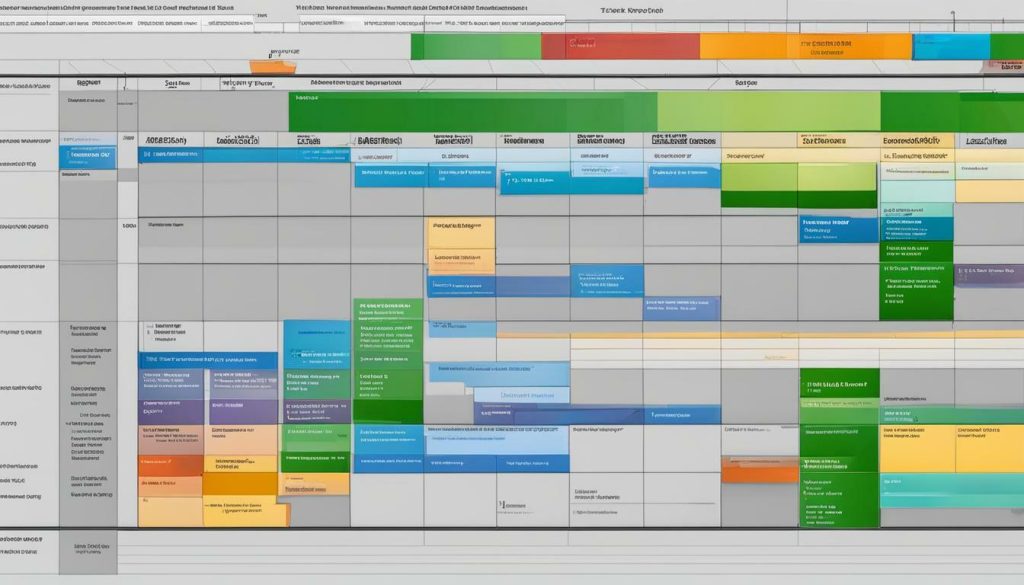
Conclusion:
In conclusion, a well-developed master schedule is a vital tool in HVAC project scheduling. It provides a clear timeline, task breakdown, and resource allocation plan, ensuring efficient and successful project execution. By following best practices and regularly monitoring progress, project managers can stay on track and deliver projects on time and within budget.
Milestone Charts for Tracking HVAC Project Progress
Milestone charts are an effective tool for tracking progress in HVAC projects and ensuring timely completion. By visually summarizing major project milestones, these charts provide a clear overview of key deliverables and deadlines. They are particularly useful for project managers, allowing them to monitor progress, identify potential bottlenecks, and take appropriate actions to keep the project on track.
To create a milestone chart, start by listing all the significant milestones in the project timeline. These milestones can include key project phases, important deadlines, major equipment installations, and client approvals. Once the milestones are identified, plot them on the chart along a horizontal timeline.
Each milestone should be represented by a distinct marker or symbol on the chart. This makes it easy to visually track the progress and see if the project is meeting its scheduled milestones. Additionally, you can include relevant information for each milestone, such as the expected completion date or any specific dependencies. This allows the project team to have a clear understanding of the critical tasks and their interdependencies.
By regularly updating the milestone chart with actual progress, you can monitor the project’s status and make informed decisions. If any delays or issues arise, it becomes evident in the chart, prompting immediate action. Moreover, milestone charts facilitate effective communication among team members, stakeholders, and clients as they provide a concise overview of the project’s progress and upcoming milestones.
| Milestone | Expected Completion Date | Actual Completion Date |
|---|---|---|
| Design Phase Approval | June 15, 2022 | June 17, 2022 |
| Equipment Procurement | June 30, 2022 | July 2, 2022 |
| Installation Phase Start | July 5, 2022 | July 6, 2022 |
| Client Inspection | July 15, 2022 | July 18, 2022 |
| Project Completion | August 1, 2022 | – |
| Final Documentation Submission | August 5, 2022 | – |
By using milestone charts in your HVAC project, you can effectively track progress, ensure timely completion, and keep all stakeholders informed about the project’s status.
![]()
Key Considerations for HVAC Project Scheduling
When creating a detailed HVAC project schedule, it is important to consider various factors that can impact the timeline and successful execution of the project. These factors include project size, weather conditions, resource availability, and permits/inspections. By addressing these considerations, you can develop a realistic and effective schedule that ensures project efficiency and meets client expectations.
Project Size
The size of the project plays a significant role in determining the timeline and resource allocation. Larger projects often require more time and resources to complete. It is essential to carefully analyze the scope of work, break down each phase, and establish realistic benchmarks to ensure a smooth and efficient workflow.
Weather Conditions
Weather conditions can have a significant impact on HVAC projects, particularly those conducted outdoors or in areas with extreme weather patterns. Adverse weather conditions, such as heavy rain, snowstorms, or extreme heat, can delay construction activities and affect the overall project schedule. It is important to consider weather forecasts and plan accordingly, allowing for potential disruptions and adjustments in the schedule.
Resource Availability
| Resource | Availability |
|---|---|
| Skilled Labor | High demand may result in limited availability. |
| Equipment | Ensure availability and maintenance. |
| Materials | Plan and coordinate timely delivery. |
Availability of resources is crucial for the smooth execution of HVAC projects. Skilled labor, equipment, and materials should be carefully planned and coordinated to avoid delays. The demand for skilled labor can sometimes exceed the available workforce, so early coordination and communication with subcontractors or labor agencies is crucial. Additionally, proper maintenance and availability of equipment and timely delivery of materials must be considered and included in the project schedule.
Permits/Inspections
- Identify and obtain all necessary permits and approvals from local authorities.
- Schedule inspections at key construction stages to ensure compliance and avoid delays.
Permits and inspections are often required for HVAC projects to ensure compliance with building codes and regulations. It is essential to identify and obtain all necessary permits and approvals from local authorities. Additionally, scheduling inspections at key construction stages is crucial to ensure compliance and avoid project delays. By incorporating permits and inspections into the project schedule, you can ensure that all necessary requirements are met and minimize the risk of unforeseen delays.

In summary, when creating an HVAC project schedule, it is crucial to consider factors such as project size, weather conditions, resource availability, and permits/inspections. By addressing these key considerations, you can develop a realistic and effective schedule that promotes project efficiency and successful completion. Proper planning, coordination, and clear communication among team members are essential to ensure the project stays on track and meets client expectations.
Conclusion
In conclusion, creating a detailed HVAC project schedule requires careful consideration of various methods and factors. By utilizing techniques such as the Critical Path Method (CPM) and the Program Evaluation and Review Technique (PERT), you can identify dependencies and estimate completion dates more accurately. Gantt charts are invaluable tools for tracking progress and resolving potential issues.
The Line of Balance (LOB) method is particularly effective for HVAC projects with repeated tasks, while quantitative scheduling optimizes resource allocation. The Last Planner System promotes effective communication and collaboration among team members, while lookahead planning ensures short-term scheduling is efficient and on track.
Master schedules compile high-level scheduling details, and milestone charts summarize key project milestones. However, it’s crucial to consider factors such as project size, weather conditions, resource availability, and permits/inspections when creating an HVAC project schedule. By adhering to best practices, maintaining clear communication, and periodically reviewing the schedule, you can enhance project efficiency and exceed expectations. Remember to be realistic, establish a plan and budget, and prioritize effective communication with your team members for a successful outcome.
FAQ
What is the Critical Path Method (CPM) in HVAC project scheduling?
The Critical Path Method (CPM) is a project scheduling approach that identifies dependent tasks and allows for adjustments to the completion date.
How does the Program Evaluation and Review Technique (PERT) help in HVAC project scheduling?
The Program Evaluation and Review Technique (PERT) estimates completion dates based on optimistic, pessimistic, and most likely schedule forecasts, aiding in accurate project scheduling.
How can Gantt charts be utilized for tracking progress in HVAC projects?
Gantt charts are effective tools for visualizing project timelines, allocating resources, and identifying problems and delays in HVAC projects.
What is the Line of Balance (LOB) method and how does it benefit HVAC project scheduling?
The Line of Balance (LOB) method optimizes resource allocation and enhances project coordination in HVAC projects with repeated tasks.
How can quantitative scheduling be implemented in HVAC projects?
Quantitative scheduling focuses on resource allocation while considering time and other constraints to ensure optimal resource utilization and project success in HVAC projects.
What is the Last Planner System and how does it contribute to HVAC project scheduling?
The Last Planner System is a holistic approach that divides projects into planning stages, promoting effective communication and collaboration among team members in HVAC project scheduling.
What is lookahead planning and how does it help in short-term scheduling for HVAC projects?
Lookahead planning involves creating a detailed schedule for the upcoming phases of an HVAC project, ensuring efficient progress and timely completion in the short term.
How can master schedules be created for comprehensive HVAC project scheduling?
Master schedules compile all high-level scheduling details for the entire HVAC project, enabling comprehensive project planning, coordination, and successful execution.
Why are milestone charts important for tracking progress in HVAC projects?
Milestone charts summarize major project milestones and are effective tools for monitoring and reporting project status in HVAC projects.
What are the key considerations for HVAC project scheduling?
Key considerations in HVAC project scheduling include project size, weather conditions, resource availability, and permits/inspections, which impact the scheduling process.

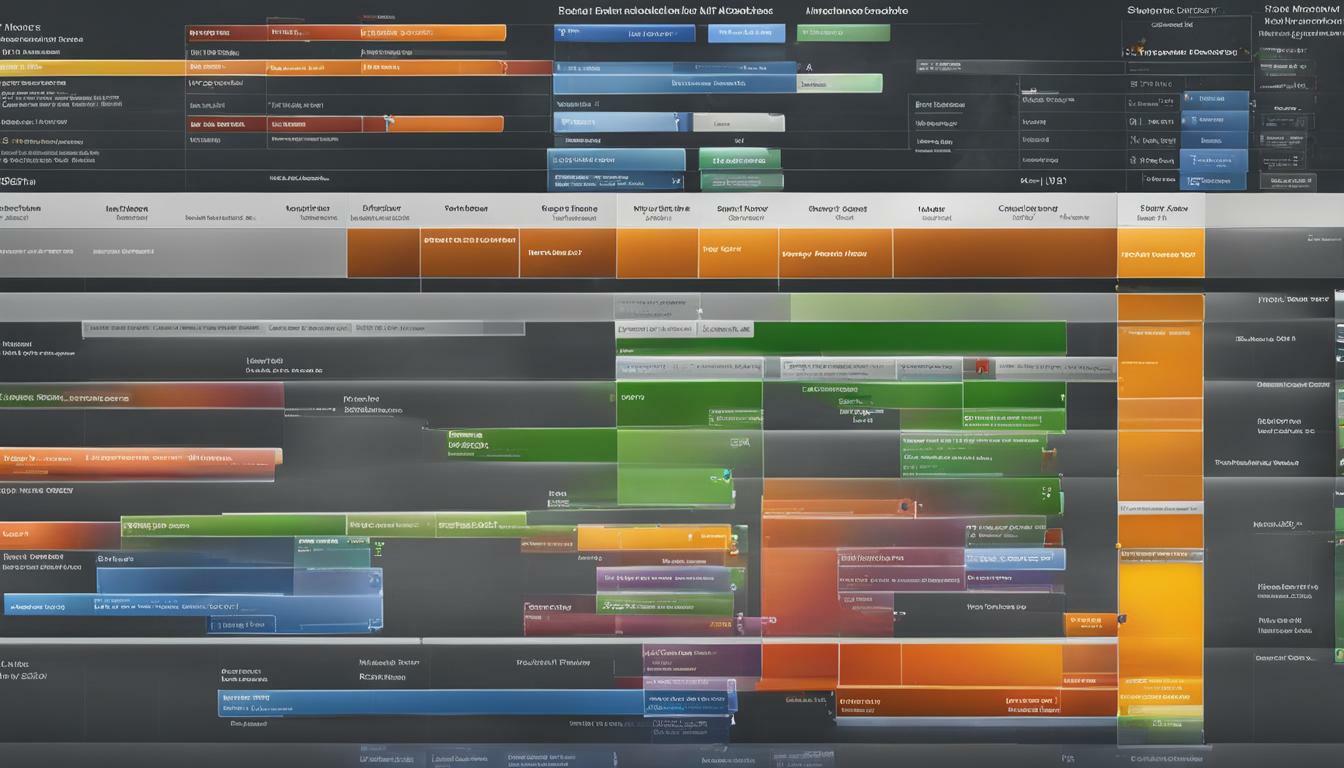



0 Comments